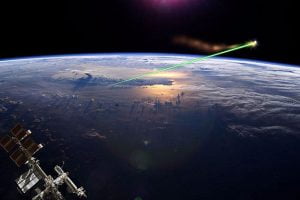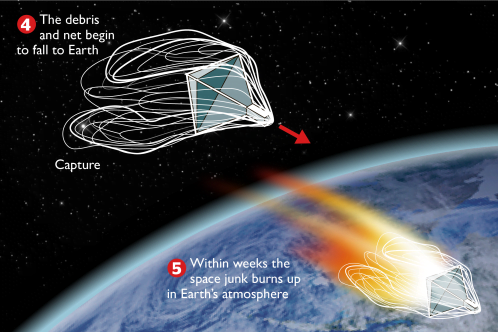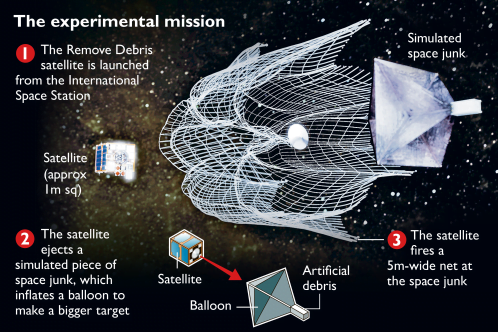By Robbin Laird
When I was in Australia, I had a chance to meet with the Australian company EOS which has very innovative laser tracking technologies which provide for Australia and her allies a key space tracking capability.
This technology has evolved to the point that not only can they asset with the domain knowledge on where satellites are but also working with tracking space debris and will soon have a deployed capability to use lasers to reduce the problem.
This capability was highlighted in an article in the Daily Mail which was published on March 21, 2018.
Australian military defence contractor Electro Optic Systems has developed a laser capable of pushing space debris in orbit around so collisions can be avoided.
The company, under its EOS Space Systems arm based in Mt Stromlo near Canberra, will use lasers to track space junk and then another higher-powered laser to avoid impacts by nudging the debris.
Professor Craig Smith, from EOS Space Systems, said researchers had developed a photon pressure laser that was ‘able to nudge space debris objects around, change their orbits.’
He said the next step would be to build ‘bigger and bigger lasers’ that were capable of pushing the debris out of orbit while avoiding breaking up the space junk into smaller pieces.
‘If they get smaller they get harder and harder to track, and so they start to become invisible — but also still lethal to satellites.’

Now another innovative player in the industry has announced success in the same domain using a different approach.
According to a story released by the University of Surrey,
The RemoveDEBRIS satellite has successfully used its on-board net technology in orbit – the first demonstration in human history of active debris removal (ADR) technology.
This satellite was built by Surrey Satellite Technology.
Sir Martin Sweeting, Chief Executive of Surrey Satellite Technology Ltd commented: “SSTL’s expertise in designing and building low cost, small satellite missions has been fundamental to the success of RemoveDEBRIS, a landmark technology demonstrator for Active Debris Removal missions that will begin a new era of space junk clearance in Earth’s orbit.”
Surrey Satellite Technology Ltd is a spin-off company from the University of Surrey and is majority owned by Airbus.
The successful mission was described in the University of Surrey article as follows:
The spacecraft began the experimental phase of its mission on Sunday 16 September, when it used a net to capture a deployed target simulating a piece of space debris.
RemoveDEBRIS was designed, built and manufactured by a consortium of leading space companies and research institutions led by the Surrey Space Centre at the University of Surrey. The spacecraft is operated in orbit by engineers at Surrey Satellite Technology Ltd in Guildford, UK. The project is co-funded by the European Commission.
Professor Guglielmo Aglietti, Director of the Surrey Space Centre, said: “We are absolutely delighted with the outcome of the net technology. While it might sound like a simple idea, the complexity of using a net in space to capture a piece of debris took many years of planning, engineering and coordination between the Surrey Space Centre, Airbus and our partners – but there is more work to be done. These are very exciting times for us all.”
Ingo Retat, Airbus RemoveDEBRIS project head, said: “To develop this net technology to capture space debris we spent 6 years testing in parabolic flights, in special drop towers and also thermal vacuum chambers. Our small team of engineers and technicians have done an amazing job moving us one step closer to clearing up low Earth orbit.”
In the coming months, RemoveDEBRIS will test more ADR technologies: a vision-based navigation system that uses cameras and LiDaR technology to analyse and observe potential pieces of debris; the first harpoon capture technology used in orbit; and a drag-sail that will finally bring RemoveDEBRIS into the Earth’s atmosphere where it will be destroyed, bringing its mission to a close.
The US Space Surveillance Network tracks 40,000 objects and it is estimated that there are more than 7,600 tonnes of ‘space junk’ in and around Earth’s orbit – with some moving faster than a speeding bullet, approaching speeds of 30,000 miles per hour.
The research leading to these results has received funding from the European Union Seventh Framework Programme [FP7/2007-2013] under grant agreement n°607099.
The RemoveDEBRIS consortium consists of:
- Mission and consortium coordination – Surrey Space Centre (UK)
- Satellite system engineering – ArianeGroup (France)
- Platform, avionics and spacecraft operations – SSTL (UK)
- Harpoon – Airbus (UK)
- Net – Airbus (Germany)
- Vision based navigation – CSEM (Switzerland)/ INRIA/ Airbus (France)
- CubeSat dispensers – Innovative Solutions in Space (Netherlands)
- Target CubeSats – Surrey Space Centre (UK)/ Stellenbosch University (South Africa)
- Dragsail – Surrey Space Centre (UK)
A London Times article provided further detail.
The article quoted the project leader and then went on to describe the potential use of the technology.
We are absolutely delighted,” Guglielmo Aglietti, director of the Surrey Space Centre., said “The target was spinning, which we had not expected. This was a demonstration of capturing an uncompetitive target.”
If the net was being used for real the satellite would then tow the junk to a lower orbit, where it would burn up as it entered the Earth’s atmosphere.
Professor Aglietti envisages nets being used to capture large pieces of debris, such as defunct satellites.
The featured graphic was contained in The Times article and is completed by the second graphic below:



